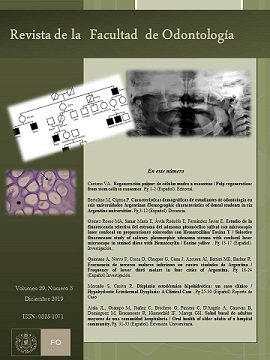Hypohydrotic Ectodermal Dysplasia: A Clinical Case
Keywords:
dentistry, hypohydrotic ectodermal dysplasia, patient managementAbstract
Ectodermal dysplasia is a rare inherited disorder distinguished by the not normal development of certain structures of ectodermal origin. The hypohydrotic ectodermal dysplasia has an autosomal recessive or X-linked inheritance, the latter being the most frequent. Patients with ectodermal dysplasia are patients who require a multidisciplinary approach to their treatment. It is of great importance that the patient is treated at an early age so that their self-esteem and their integration into society are not affected. Due to the oral characteristics of the DEH, the most common treatment is the elaboration of total prostheses, although the clinician may face various difficulties such as the poor development of alveolar processes and dry mouth, resulting from the poor or no salivary secretion.
Downloads
References
2. Vieira KA, Teixeira MS, Guirado CG, Gaviao MB. Prosthodontic treatment of hypohidrotic ectodermal dysplasia with complete anodontia: case report. Quintessence Int. 2007; 38: 75-80.
3. Hekmatfar S, Jafari K, Meshki R, Badakhsh S. Dental management of ectodermal dysplasia: two clinical case reports. J Dent Res Dent Clin Dent Prospects. 2012; 6 (3): 108-112.
4. Itthagarun A, King N. Ectodermal dysplasia: a review and case report. Quintessence Int. 1997; 28: 595-602.
5. Pae A, Kim K, Kim HS, Kwon KR. Overdenture restoration in a growing patient with hypohidrotic ectodermal dysplasia: a clinical report. Quintessence Int. 2011; 42: 235-238.
6. Yap A, Klineberg I. Dental implants in patients with ectodermal dysplasia and tooth agenesis: a critical review of the literature. Int J Prosthodont. 2009; 22: 268-276.
7. Pipa A, López E, González M, Martínez M, Blanco F. Treatment with removable prosthesis in hypohidrotic ectodermal dysplasia. A clinical case. Med Oral Patol Oral Cir Bucal. 2008; 13 (2): 119-123.
8. Kaul S, Reddy R. Prosthetic rehabilitation of an adolescent with hypohidrotic ectodermal dysplasia with partial anodontia: case report. J Indian Soc Pedod Prevent Dent. 2008; 26 (4): 177-181.
9. Bergendal B. The role of prosthodontists in habilitation and rehabilitation in rare disorders: the ectodermal dysplasia experience. Int J Prosthodont. 2001; 14: 466-470.
10. Crawford P, Aldred MJ, Clarke A. Clinical and radiographic dental findings in X linked hypohidrotic ectodermal dysplasia. Journal of medical genetics.1991; 28(3):181-85.
11. Neves FS, Ladeira DBS, Nery LR, Neves EG, de Almeida SM. Displasia ectodérmica: relato de dois casos clínicos ectodermal dysplasia: report of two clinical cases. Caros leitores,2011.
12. Jorgenson RJ. Perspective on the classification of ectodermal dysplasia. Am J Med Genet A. 2009; 149A(9):2057-2061.
13. Srivastava V. Ectodermal dysplasia: A case report. Int J Clin Pediatr Dent. 2011;4(3):269-270.
14. Balci G, Baskin SZ, Akdeniz S. Ectodermal dysplasia: Report of four cases and review of literature. Int Dental & Med Disorders. 2008;1(1):56-59.
15. Prasad P, Al-Kheraif A, Kathuria N, Madhav V, Ramakrishnaiah S. Ectodermal dysplasia: Dentalmanagement and complete denture therapy. W Applied Sci J. 2012; 20(3):423-428.
16. Itthagarun A, King NM. Ectodermal dysplasia: A review and case report. Quintessence Int. 1997;28(9):595-602.
17. Gupta AA, Gotmare SS, Jain M, Pereira T, Khare P. Hypohydrotic Ectodermal Dysplasia in an Indian Family. J Coll Physicians Surg Pak. 2019 Apr;29(4):381-383. doi: 10.29271/jcpsp.2019.04.381.
Published
Issue
Section
License
Aquellos autores/as que tengan publicaciones con esta revista, aceptan los términos siguientes:
- Los autores/as conservarán sus derechos de autor y garantizarán a la revista el derecho de primera publicación de su obra, el cuál estará simultáneamente sujeto a la Licencia de reconocimiento de Creative Commons que permite a terceros:
- Compartir — copiar y redistribuir el material en cualquier medio o formato
- La licenciante no puede revocar estas libertades en tanto usted siga los términos de la licencia
- Los autores/as podrán adoptar otros acuerdos de licencia no exclusiva de distribución de la versión de la obra publicada (p. ej.: depositarla en un archivo telemático institucional o publicarla en un volumen monográfico) siempre que se indique la publicación inicial en esta revista.
- Se permite y recomienda a los autores/as difundir su obra a través de Internet (p. ej.: en archivos telemáticos institucionales o en su página web) después del su publicación en la revista, lo cual puede producir intercambios interesantes y aumentar las citas de la obra publicada. (Véase El efecto del acceso abierto).

